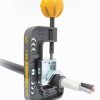Is that the one with a short piece of 'hacksaw' blade, not used one myself but known lots of swearing at them. I was taught with a pipe slice and as long as it's got a sharp wheel it works well. However there always seems to be a saw available and that seems to be my go to now.Why was this bumped? Thought B-A-S was back for a moment!
Anyway a CK Armour slice is a perfect tool for small SWA 25mm and smaller. I used one for Two years terminating mainly 6mm and hardly ever needed to replace the blades. You have to make sure you turn it in the correct direction. The Yellow Ball fell off mine until I got my father inlaw to drill it & put a pin to stop it coming off

That seems to be me who's bumped this, I didn't realise it is so 'last year' and again I didn't get an old thread warning.
This is a very common mistake and I've had to fix far too many. The second nut should be fine if done up tightenough as there will usually be enough slack against the plastic, regardless of how tight it was made.Except for the incorrect advice on connecting the earth. As he's done it, the integrity of the earth is dependent on the clamping pressure with a piece of plastic in the "sandwich" - and given that plastic will creep under pressure, it is "most likely" that the clamping pressure of the connections will be lost over time. Add a bit of tarnishing to the brass, and you've an unreliable earth.
Needs either two nuts on the gland (one to clamp it into the box, the second to clamp the banjo down onto the first*), or there are clamps (who's name escapes me at the moment, but I'm sure someone will remember for me) specifically for doing it in a more reliable way.
* Even this isn't reliable if not done right. There's play in the threads, so if you do the first nut up to "T A F" and then put the second nut on, as the plastic creeps, the first nut will be free to move by however much play there is in the threads - and the clamping pressure of the second nut will be relieved.
Instead, don't fully tighten the first nut, so that when you tighten the second one, it pushes the first nut down a bit harder, taking up the play in the threads - if you imagine how the nuts would be if the plastic panel weren't there, that's how you want them when the plastic is there.
Pirana nut.
Of course It doesn't have to be a brass gland, the cable can be done with a stuffing gland into a pastic enclosure and then either terminate the steel wires directly into terminals or fit a brass clamp ring on the armour. We seem to have got hung up on a single method.

